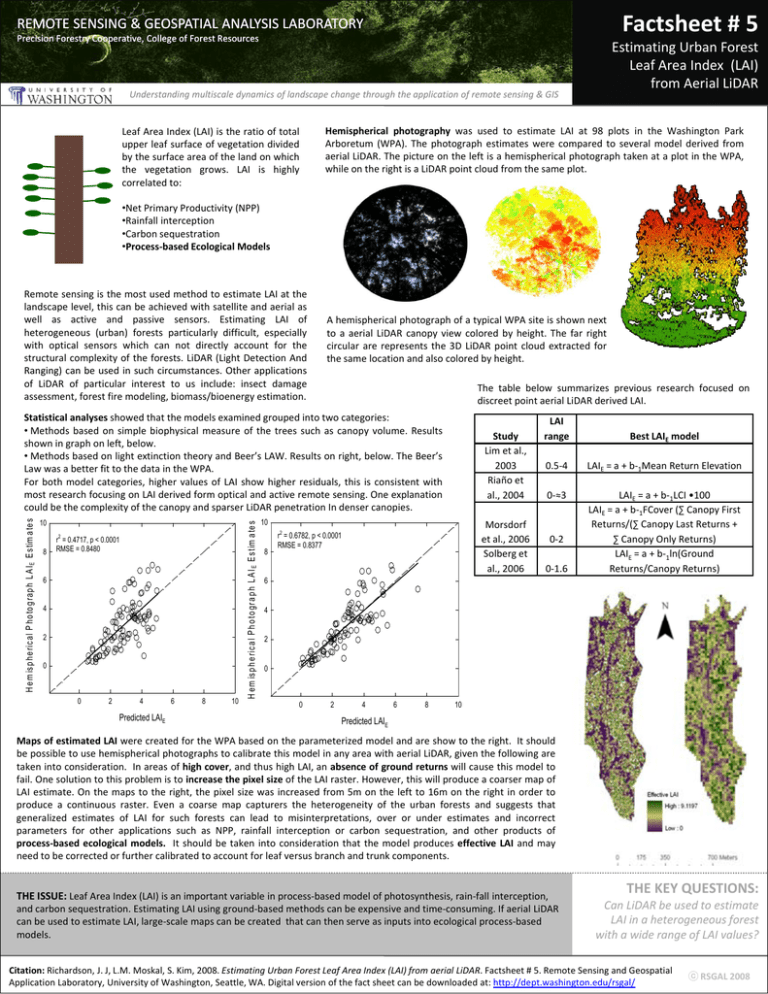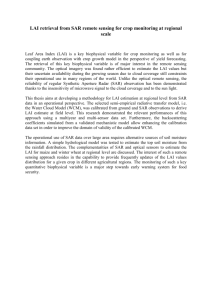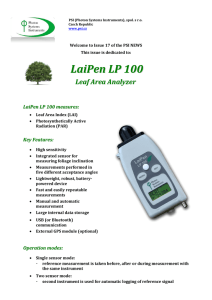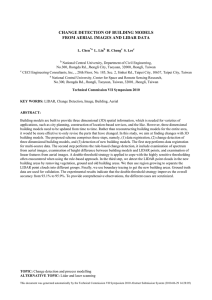Factsheet # 5
advertisement

Factsheet # 5 REMOTE SENSING & GEOSPATIAL ANALYSIS LABORATORY Precision Forestry Cooperative, College of Forest Resources Estimating Urban Forest Leaf Area Index (LAI) from Aerial LiDAR Understanding multiscale dynamics of landscape change through the application of remote sensing & GIS Leaf Area Index (LAI) is the ratio of total upper leaf surface of vegetation divided by the surface area of the land on which the vegetation grows. LAI is highly correlated to: Hemispherical photography was used to estimate LAI at 98 plots in the Washington Park Arboretum (WPA). The photograph estimates were compared to several model derived from aerial LiDAR. The picture on the left is a hemispherical photograph taken at a plot in the WPA, while on the right is a LiDAR point cloud from the same plot. •Net Primary Productivity (NPP) •Rainfall interception •Carbon sequestration Process based Ecological Models •Process‐based Remote sensing is the most used method to estimate LAI at the landscape level, this can be achieved with satellite and aerial as well as active and passive sensors. Estimating LAI of heterogeneous (urban) forests particularly difficult, especially with optical sensors which can not directly account for the structural complexity of the forests. LiDAR (Light Detection And Ranging) can be used in such circumstances. circumstances Other applications of LiDAR of particular interest to us include: insect damage assessment, forest fire modeling, biomass/bioenergy estimation. A hemispherical photograph of a typical WPA site is shown next to a aerial LiDAR canopy view colored by height. The far right circular are represents the 3D LiDAR point cloud extracted for the same location and also colored by height. The table below summarizes previous research focused on discreet point aerial LiDAR derived LAI. 10 2 8 r = 0.4717, p < 0.0001 RMSE = 0.8480 6 4 2 0 0 2 4 Predicted LAIE 6 8 10 H e m is p h e ric a l P h o to g ra p h L A I E E s tim a te s H e m is p h e ric a l P h o to g ra p h L A I E E s tim a te s Statistical analyses showed that the models examined grouped into two categories: • Methods based on simple biophysical measure of the trees such as canopy volume. Results shown in graph on left, below. • Methods based on light extinction theory and Beer’s LAW. Results on right, below. The Beer’s Law was a better fit to the data in the WPA. For both model categories, higher values of LAI show higher residuals, this is consistent with most research focusing on LAI derived form optical and active remote sensing. sensing One explanation could be the complexity of the canopy and sparser LiDAR penetration In denser canopies. Study Lim et al., 2003 Riaño et al 2004 al., 2004 10 8 Morsdorf et al., 2006 Solberg et al., 2006 r2 = 0.6782, p < 0.0001 RMSE = 0.8377 LAI range Best LAIE model 0.5‐4 LAIE = a + b‐1Mean Return Elevation 0‐≈3 0 ≈3 LAIE = a + b = a + b‐1LCI •100 LCI •100 LAIE = a + b‐1FCover (∑ Canopy First Returns/(∑ Canopy Last Returns + ∑ Canopy Only Returns) LAIE = a + b‐1ln(Ground Returns/Canopy Returns) 0‐2 0‐1.6 6 4 2 0 0 2 4 6 8 10 Predicted LAIE Maps p of estimated LAI were created for the WPA based on the p parameterized model and are show to the right. g It should be possible to use hemispherical photographs to calibrate this model in any area with aerial LiDAR, given the following are taken into consideration. In areas of high cover, and thus high LAI, an absence of ground returns will cause this model to fail. One solution to this problem is to increase the pixel size of the LAI raster. However, this will produce a coarser map of LAI estimate. On the maps to the right, the pixel size was increased from 5m on the left to 16m on the right in order to produce a continuous raster. Even a coarse map capturers the heterogeneity of the urban forests and suggests that generalized estimates of LAI for such forests can lead to misinterpretations, over or under estimates and incorrect parameters for other applications such as NPP, rainfall interception or carbon sequestration, and other products of process‐based ecological models. It should be taken into consideration that the model produces effective LAI and may need to be corrected or further calibrated to account for leaf versus branch and trunk components. THE ISSUE: Leaf Area Index (LAI) is an important variable in process‐based model of photosynthesis, rain‐fall interception, and carbon sequestration. Estimating LAI using ground‐based methods can be expensive and time‐consuming. If aerial LiDAR can be used to estimate LAI, large‐scale maps can be created that can then serve as inputs into ecological process‐based models. THE KEY QUESTIONS: Can LiDAR be used to estimate LAI in a heterogeneous forest with a wide range of LAI values? Citation: Richardson, J. J, L.M. Moskal, S. Kim, 2008. Estimating Urban Forest Leaf Area Index (LAI) from aerial LiDAR. Factsheet # 5. Remote Sensing and Geospatial Application Laboratory, University of Washington, Seattle, WA. Digital version of the fact sheet can be downloaded at: http://dept.washington.edu/rsgal/ ⓒ RSGAL 2008




